Citizen Science with the Transit of Mercury – SkyandTelescope.com
If you’re planning on watching the November 11th transit of Mercury, try kicking it up a notch — watch with a friend and calculate the distance between Earth and the Sun!
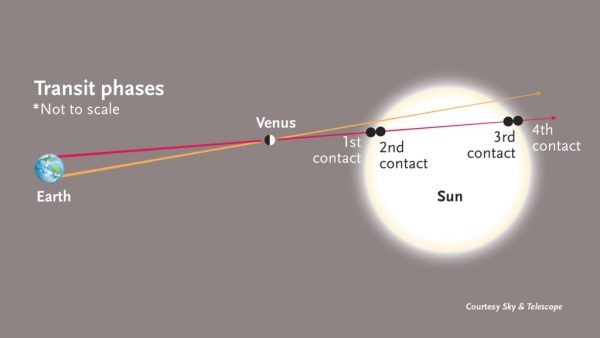
English astronomer Edmond Halley realized that astronomers could utilize the transit of Venus to triangulate the absolute distance from Earth to Venus, and thus to the Sun. On November 11th, observers have a chance to use a similar method with the transit of Mercury.
Our solar system is an impressively large place. But figuring out just how large took humanity a long time. Ancient astronomers used geometry to piece together a picture of the relative distances between planets and the Sun, but they couldn’t measure those distances in absolute terms.
The missing piece of the puzzle was the average distance from Earth to the Sun – also known as the astronomical unit (a.u., for short). Once astronomers knew the a.u., the true size and scale of the solar system would become clear.
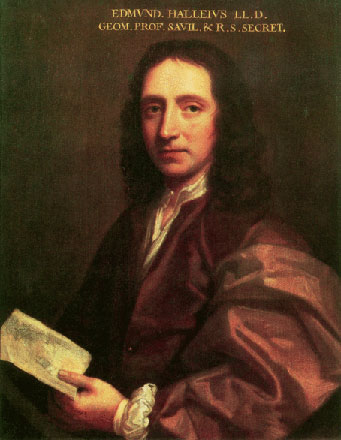
Edmond Halley devised an ingenious method to calculate the scale of the solar system by observing the transits of Venus from both hemispheres.
Nobody figured out how to measure the a.u. until Sir Edmund Halley (1656-1742). Halley determined that when Venus crossed the Sun from Earth’s perspective, observers at widely separated locations would see the planet’s silhouette against the Sun at different positions. By measuring the shift, or parallax, in Venus’ apparent position on the Sun’s surface, astronomers could calculate the absolute distance between Earth and the Sun.
There were really only a few measurements necessary:
- Distance between the observing sites.
- Parallax shift of the planet.
- Maximum angle of elongation (angle between the planet and the Sun – look this value up in planetarium software)
Unfortunately, Halley died before the next transit of Venus, which occurred in 1761, so he never saw his technique in action. (Even then, expeditions to observe the transit failed, for various reasons, to make the needed measurements; expeditions for the 1769 transit had somewhat better results.)
For modern-day astronomers and stargazers, the 2006 and 2012 transits of Venus presented an opportunity to recreate this historic measurement. Venus won’t transit the Sun again until 2117, but now observers have a similar opportunity with the upcoming transit of Mercury.
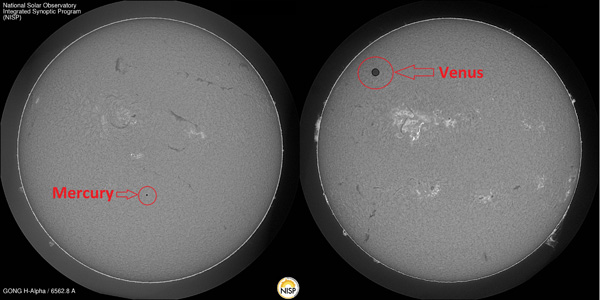
This comparison of past transits of Mercury and Venus (in 2016 and 2012, respectively) is drawn from data collected by the National Solar Observatory’s Global Oscillation Network Group.
GONG / NSO / Z. Stockbridge
Citizen ToM
On Monday, November 11th, the Citizen Transit of Mercury (ToM) Project will use Halley’s technique to measure the distance to the Sun using the transit of Mercury instead of Venus. Although Mercury appears much smaller than Venus against the Sun, the approach to measuring the Sun’s distance is the same.
More than a dozen observing sites spread across the country and using identical equipment (from the 2017 Citizen CATE total solar eclipse project) will take simultaneous images of the transit. Most participants are students, who will have a rare opportunity to make one of the most important measurements in astronomy from scratch.
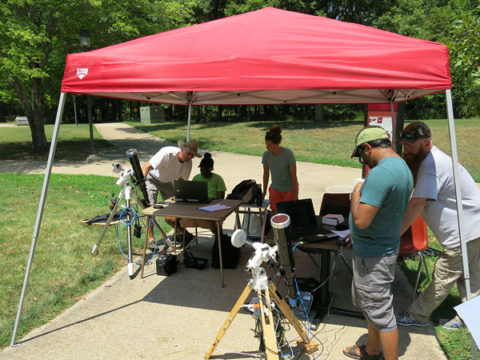
This image shows observers with the Citizen CATE project at Southern Illinois University as they recorded the 2017 total solar eclipse. The Citizen ToM Project will use the same equipment.
Bob Baer (SIU)
The principles behind measuring the a.u. are simple, but as with many things in science, implementation is tricky. With modern clocks and GPS, precision timing and determining the exact distance between locations is easy. Instead, the biggest challenge is the spotless Sun.
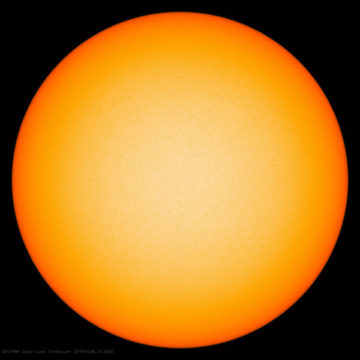
If the Sun remains spotless, aligning images of the transit taken from multiple sites will prove to be a challenge. Current images of the Sun can be found here.
SDO / HMI / NASA
The Sun is currently at the bottom of an 11-year cycle of magnetic activity, which is why the Sun’s face appears featureless. Without sunspots, it’s difficult to align images from multiple observing sites. Image alignment needs to be as precise as possible because Mercury’s apparent position will only shift a small amount. The maximum shift that could be observed, just under 13 arcseconds, would require observers in Antarctica and northern Canada; closer observing sites will see a smaller parallax.
One way to make image alignment easier is to use a Herschel Wedge, a highly specialized optical prism that refracts most sunlight out of the optical path. Using these instead of traditional solar filters will provide the clearest white-light views with the highest possible contrast. Lunt Solar Systems has donated four solar wedges to the Citizen ToM Project to use at locations near the coasts. Taking hydrogen-alpha images using a solar telescope is another, albeit more expensive option.
DIY Transit Measurement
If you want to measure the a.u. for yourself, there are several ways to do it. It really just involves coordinating an exact observing time with someone far away from you, then sharing your images for analysis. Ideally, you and your friend would both have the same camera and telescope so your images would be the same scale, but this is not strictly necessary. Take pictures of Mercury at the same exact time during the transit. Then, after the event, align your two images to see how far Mercury’s position changes. Rotating the images precisely before comparing them will likely be your biggest obstacle since having both cameras identically aligned is a challenge.
Of course, if you can’t find an observing partner far enough away or if you have bad weather, you can always cheat . . . Use images of the Sun from the National Solar Observatory’s GONG network! The GONG H-alpha telescopes are identical, spread across the world, and you can access the data with the GONG Data Archive.
If you are interested in finding an observing partner and measuring the a.u. for yourself, you can find more details in the Solar System Imaging & Processing forum on Cloudy Nights.
Whether or not you try to revive Halley’s methods, be sure you get out to see this transit. Mercury will transit again in 2032 and 2039 for observers in Europe, Africa, and Asia. Observers on the other side of the world who miss the November 11th transit will have to choose between buying an international plane ticket or waiting until 2049.






